Learning to Drive
Comment via blog
Prev
Next


|
Day 4: September 19, 2021 Learning to Drive Comment via blog |
Prev Next |
 
|
|
|
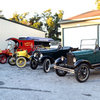
 The Model T driving school is held behind the
AACA Museum at
the base of a small hill. Parking is next to the museum at the top of the
hill which provided a good look at the cars to be used as I walked to
class. Before entering the building, I took another picture of the fleet.
The Model T driving school is held behind the
AACA Museum at
the base of a small hill. Parking is next to the museum at the top of the
hill which provided a good look at the cars to be used as I walked to
class. Before entering the building, I took another picture of the fleet.
|
|
|
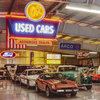

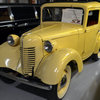
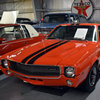
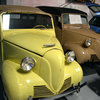 Every museum has some storage area for items not currently on display. The
school, technically the Model T Driving Experience, starts in just such a
storage area. Students are allowed to roam through the area and there is
plenty of time to do so.
Every museum has some storage area for items not currently on display. The
school, technically the Model T Driving Experience, starts in just such a
storage area. Students are allowed to roam through the area and there is
plenty of time to do so.
That 1977 Cadillac is Betty White's "Canary". Other cars that caught my eye included a 1939 American Bantam (Like the one Jack Rittenhouse drove while researching "A Guidebook to Highway 66".), a great looking AMX, and a pair of rare pre-war Crosleys. |
|
|
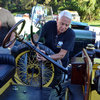
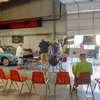 Class started inside with some "theory of operation" stuff
using diagrams, photos, and hand motions. It wasn't long before we moved
outside where the waiting Ts replaced the diagrams and photos. At some
level, I knew the basics but not the subtleties and even the most basic
bits needed refreshing. One thing that I was already knew and which I
would hear repeated several times throughout the day was, "Forget
everything you know about driving." Operating a Model T bears almost
no resemblance to operating a modern car. A partial exception is the
steering wheel. Clockwise movement does turn the car to the right and
vice versa but the resemblance ends there. Most modern cars have a
steering ratio of 12:1 or more; the ratio for Ts is 4:1 or 5:1. A small
hand movement yields a big directional change.
Class started inside with some "theory of operation" stuff
using diagrams, photos, and hand motions. It wasn't long before we moved
outside where the waiting Ts replaced the diagrams and photos. At some
level, I knew the basics but not the subtleties and even the most basic
bits needed refreshing. One thing that I was already knew and which I
would hear repeated several times throughout the day was, "Forget
everything you know about driving." Operating a Model T bears almost
no resemblance to operating a modern car. A partial exception is the
steering wheel. Clockwise movement does turn the car to the right and
vice versa but the resemblance ends there. Most modern cars have a
steering ratio of 12:1 or more; the ratio for Ts is 4:1 or 5:1. A small
hand movement yields a big directional change.
Every student would drive all of the four cars. All were fitted with electric starters which was deeply appreciated by both instructors and students. Students were also spared dealing with other intricacies of getting an engine running. The instructors handled things like spark advance and battery/magneto selection. |
|
|
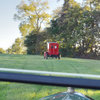

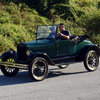
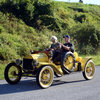
 Students make their first trip around the course as a passenger. I had my
camera along and took the first picture on that lap. I left it behind
without lining up a photographer when I moved to the driver's seat. The
other pictures in this panel are of the first two cars I drove but not
with me in them. I stepped abound the corner of the building to catch the
cars on course with the student as both passenger and driver.
Students make their first trip around the course as a passenger. I had my
camera along and took the first picture on that lap. I left it behind
without lining up a photographer when I moved to the driver's seat. The
other pictures in this panel are of the first two cars I drove but not
with me in them. I stepped abound the corner of the building to catch the
cars on course with the student as both passenger and driver.
|
|
|
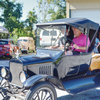

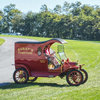
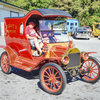
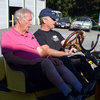 I did recruit someone to snap pictures when I got into the yellow car.
There was some play in the steering on this car and the instructor felt
that a lap as passenger was in order. I've no doubt that this was a good
idea but it did result in no picture of me driving.
I did recruit someone to snap pictures when I got into the yellow car.
There was some play in the steering on this car and the instructor felt
that a lap as passenger was in order. I've no doubt that this was a good
idea but it did result in no picture of me driving.
The fellow I handled the camera to when I climbed into the third car took multiple pictures including some from the side of the building with the car on course and me driving. The car is partially enclosed which means I'm somewhat hidden in the pictures but only you can decide if that's a good thing or a bad thing. Each one of the cars was a little different and this one had something of a dead spot in the throttle which made it function sort of like an on/off switch. I managed to stall the car twice. The last car I drove was also covered because the third open car had faltered and been replaced by this one. Both were actually convertible pickups but this one had its top up. One of the instructors was my cameraman for this drive and he had no problem stepping around to the driver's side for a picture. It is a picture I used in b&w form as my IG/FB/Twitter picture of the day. I also stalled this car but I have an excuse. The previous driver had set the hand brake which was not the normal procedure. The instructor figured that out just before the engine stopped as I tried to climb the hill. |
|
|
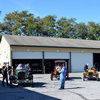
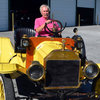 After all the students had driven all four vehicles and received their
"diplomas", the cars were used to
provide rides to those who had signed up as passengers only and for photo
ops.
After all the students had driven all four vehicles and received their
"diplomas", the cars were used to
provide rides to those who had signed up as passengers only and for photo
ops.
|
|
|
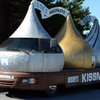
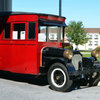 It was now time to check out the actual museum but before going inside I
paused at a couple of vehicles parked outside. I recognized one of them
from its time at Afton
Station in Oklahoma.
It was now time to check out the actual museum but before going inside I
paused at a couple of vehicles parked outside. I recognized one of them
from its time at Afton
Station in Oklahoma.
|
|
|

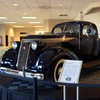
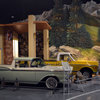
 A temporary exhibit features light-duty trucks. The 1959 El Camino and
1937 Studebaker are in the lobby area. The 1959 Ranchero and 1972 GMC are
in the main display area along with the 1956 Plymouth. The Plymouth is an
Australian product.
A temporary exhibit features light-duty trucks. The 1959 El Camino and
1937 Studebaker are in the lobby area. The 1959 Ranchero and 1972 GMC are
in the main display area along with the 1956 Plymouth. The Plymouth is an
Australian product.
|
|
|
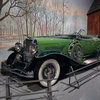
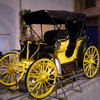
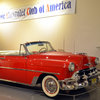 I believe these three are all part of the museum's permanent collection. I
was surprised to see they had a '53 Chevy exactly like my first car. Some
details are different, of course. Like mine was green and had four doors
and a roof, but otherwise... The 1896 Benton Harbor was the first car
donated to the museum. In 1930, the gorgeous Duesenberg was the fastest
and most expensive car built in America.
I believe these three are all part of the museum's permanent collection. I
was surprised to see they had a '53 Chevy exactly like my first car. Some
details are different, of course. Like mine was green and had four doors
and a roof, but otherwise... The 1896 Benton Harbor was the first car
donated to the museum. In 1930, the gorgeous Duesenberg was the fastest
and most expensive car built in America.
|
|
|
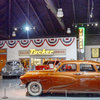
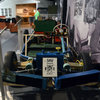
 The museum has an impressive Tucker display that includes Test Chassis #2
and Tucker #1001. 1001 was the first car off the prototype production
line.
The museum has an impressive Tucker display that includes Test Chassis #2
and Tucker #1001. 1001 was the first car off the prototype production
line.
|
|
|

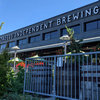 I figured all the school kids in Hershey went to
Troegs after class.
I figured all the school kids in Hershey went to
Troegs after class.
|
|
|

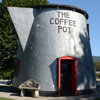
 In Bedford, I like to give Dunkel's classic gas station as much business
as I can and had just bought enough gas in Allentown to get me here. I may
have known that it's closed on Sundays but had forgotten so had to grab
some gas elsewhere after snapping a picture.
In Bedford, I like to give Dunkel's classic gas station as much business
as I can and had just bought enough gas in Allentown to get me here. I may
have known that it's closed on Sundays but had forgotten so had to grab
some gas elsewhere after snapping a picture.
Of course, the coffee pot at the fairgrounds wasn't closed because it's never really open. Today there was something going on at the fairgrounds that apparently let out about the time I arrived. All of the cars exiting made it unusually difficult to pull away from the pot. I had planned on dinner at Jean Bonnet's but found it closed. I've learned that a staff shortage has meant temporary Sunday closures. |
|
|
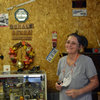

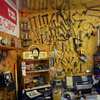

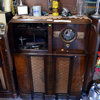
 Knowing that Ron Miller had died last October, I expected his radio museum
to be closed. I pulled in merely to snap a picture but as I started to
back out, someone appeared from the house. It was Ron's daughter Chris who
fully intends to keep the place going. In fact, she has enlarged it. After
looking over the stuff I was slightly familiar with in the original
museum, I was led to the garage which has become a museum annex. It
contains, not surprisingly, mostly radios and related items. Non-audio
stuff includes a couple of pedal cars. A mannequin stands near the center
of the back wall wearing Ron's old uniform. His workbench is intact in the
far corner. Chris' camera collection fills another corner. She seemed
familiar with every item in both sections and happily shared her
knowledge. After the other neighborhood closures, it was a nice surprise
to fine the museum open and in good hands.
Knowing that Ron Miller had died last October, I expected his radio museum
to be closed. I pulled in merely to snap a picture but as I started to
back out, someone appeared from the house. It was Ron's daughter Chris who
fully intends to keep the place going. In fact, she has enlarged it. After
looking over the stuff I was slightly familiar with in the original
museum, I was led to the garage which has become a museum annex. It
contains, not surprisingly, mostly radios and related items. Non-audio
stuff includes a couple of pedal cars. A mannequin stands near the center
of the back wall wearing Ron's old uniform. His workbench is intact in the
far corner. Chris' camera collection fills another corner. She seemed
familiar with every item in both sections and happily shared her
knowledge. After the other neighborhood closures, it was a nice surprise
to fine the museum open and in good hands.
|
|
|

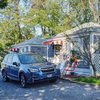
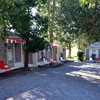
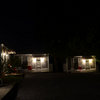
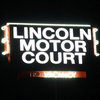 It has been too long since I was last here but the
Lincoln
Motor Court is just as cool and comfortable as ever. It's a real gem
that's for sale because, after 39 years, Bob and Debby would kind of like
to retire. Although I can't blame them, it sure was nice chatting with
Debby when I checked in and got the key to this
room. Yeah, that's the moon, just a day away from full, next to the
sign.
It has been too long since I was last here but the
Lincoln
Motor Court is just as cool and comfortable as ever. It's a real gem
that's for sale because, after 39 years, Bob and Debby would kind of like
to retire. Although I can't blame them, it sure was nice chatting with
Debby when I checked in and got the key to this
room. Yeah, that's the moon, just a day away from full, next to the
sign.
|
|
|
| [Prev] [Site Home] [Trip Home] [Contact] [Next] |